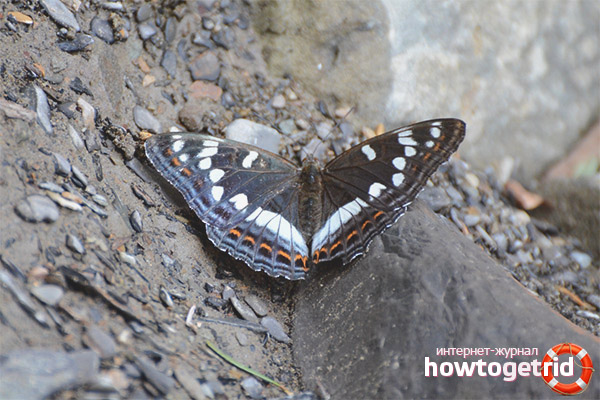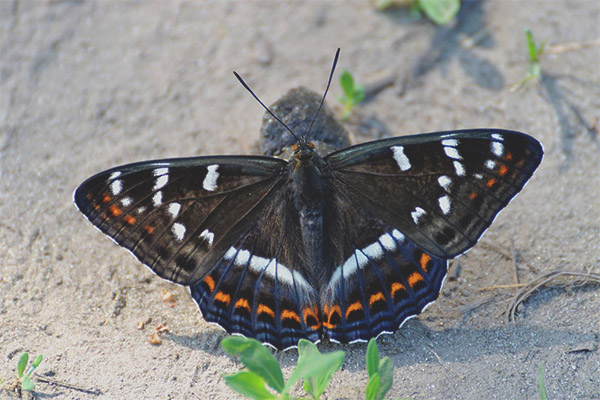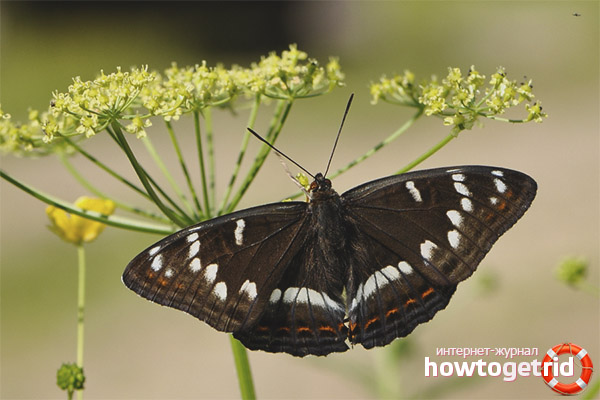The content of the article
In the warm period of time on the forest edges or the banks of reservoirs you can find butterflies with characteristic spots on the wings. This butterfly poplar lentochnik, it replenishes its reserves of trace elements.
Description
Poplar lentochnik - one of the largest butterflies belonging to the family nymphalida. Its wingspan leaves from 6 to 8.5 cm. The surface of the wings has a dark brown color, in the sun you can see the green-blue, mother-of-pearl overflow.
On the front wings, the drawing consists of white spots scattered in a chaotic order and small orange holes along the edge. The rear wings are decorated with a white border and a pattern of rich orange and black spots.
The lower part of the wings is red-orange with blue or gray-blue edging. Drawing from merging small or separate large white spots.The front wings are more elongated, in turn, the rear ones have rounded outlines and a wave-like margin of pale blue or white.
The head of the insect is large with large faceted eyes, without hairs. The body of a poplar lentochnik is monophonic, dark brown color. Limbs walking, shortened front legs. Such a feature is a feature of all representatives of the nymphalid species. Reduced legs are not suitable for walking, as they have no claws, as well as segments. In this case, the limbs of a butterfly are densely dotted with hairs and are considered an organ of touch, thanks to them the insect finds food.
Subspecies
Butterflies poplar lentochnika depending on the color of the wings are divided into 4 types:
- Main.
- Japanese.
- Butterflies that live mainly in the Amur region, with bands and large white spots.
- Lentochnik with a predominant metallic luster, lives in China and Tibet.
Habitat
This species of butterflies is widely distributed in the countries of Northern and Eastern Europe and Asia. Lentochnik, formerly inhabited in Denmark, is no longer found in these parts, nor can he be met in England, Spain, and Italy.In Russia, the insect lives in Siberia, Transcarpathia, the Far East, and is often found in Japan, China, Mongolia and the mountainous regions of Tibet.
Lifestyle

Compared to most diurnal butterflies, this species prefers to live in secrecy. Female lentochnika most of the day hiding in the canopy of trees and fly down only to eat. Their food is made up of flowers or organic residues. More often it is possible to observe males gathering in whole groups on forest paths or in places with high humidity.
There is a poplar lentochnik in mixed forests, groves and fields with fodder plants. In addition, asphalt roads cause great interest to them, due to the heat they generate and the possibility of finding additional food.
The diet of this species consists of animal excrement, the corpses of frogs, mouse-like rodents, putrefactive fruits, less often flowers and umbrella plants.
Within the range of habitat, imago begins years from June to July, in warm regions from May.
Males of the foxet appear from the pupae before females. During the year only one generation can develop.Butterflies are capable of moving quickly and easily over long distances. By the end of the life cycle, they fly away from their usual places to a moorland or agricultural land.
Reproduction of poplar lentochnika
Even before the release of the female from the pupa, the males saturate the body with microelements and proceed to the division of the territory into separate sections. This is a characteristic behavior for the entire species. After the mating period is over, the female lays an egg on the edge of a leaf of the tree, in 7 days the embryo will develop enough and leave the shell. The caterpillar ripens on willow, poplar or aspen.
The hatching caterpillars are initially black with numerous warts all over the body, after wintering they grow noticeably up to 5 cm in length and change color to green with dark brown spots. The head of an insect is colored brown with two bulky horns. As a rule, they pupate on the leaves of trees in the month of June. The pupa is rather large, yellow, with small spots of black color. After 2 weeks, a representative of a new generation of poplar lentochnik will appear from it.
Insect numbers
Every year the number of this species of butterflies changes, and, above all, it is connected with such factors:
- Weather conditions. Sharp cooling and bad weather contribute to the death of males, in turn, unfertilized females are not able to lay eggs.
- Various diseases.
- Attack of predators and the influence of parasites.
- Death on the roads. About 15% of males die under the wheels of vehicles.
- Deforestation.
All of the above factors significantly reduce the population of this species of butterflies. In some European countries and regional regions of Russia poplar lentochnik is listed in the Red Book.
Video: Butterfly Ribbon (Limenitis populi)












To send